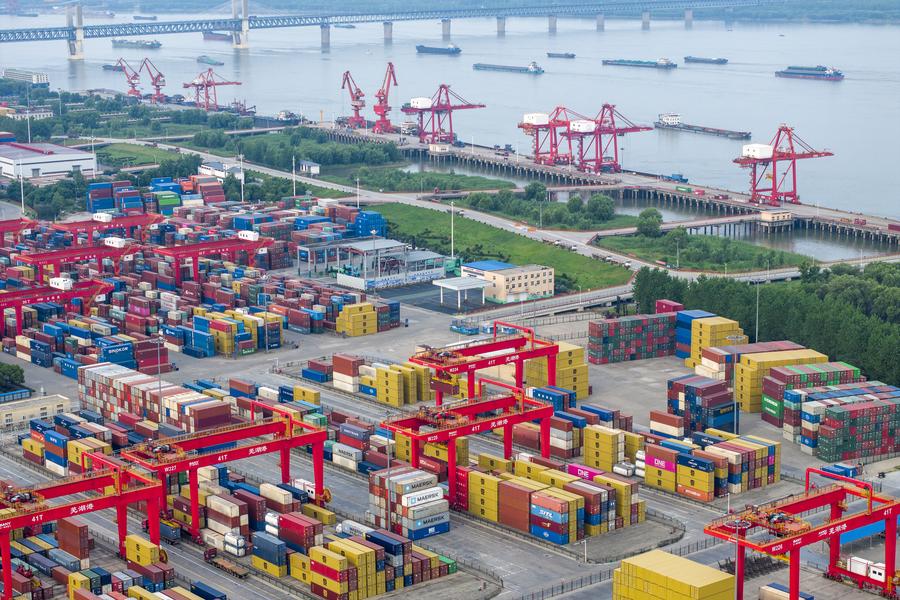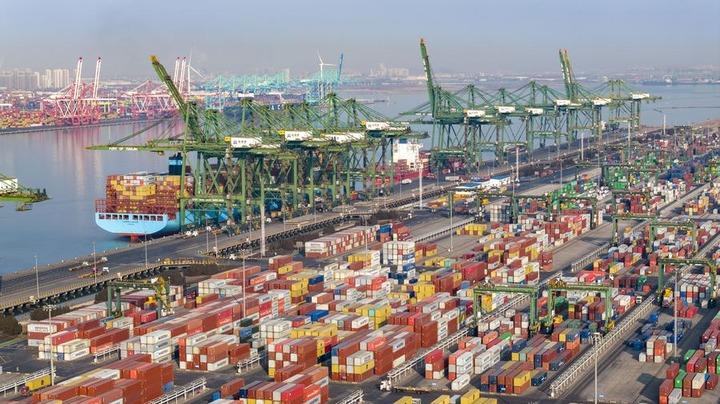An aerial drone photo taken on May 26, 2024 shows an international container terminal of Zhujiaqiao area at Wuhu Port in Wuhu City, east China's Anhui Province. (Photo by Xiao Benxiang/Xinhua)
BEIJING, July 5 (Xinhua) -- Amid escalating trade tensions, a wide array of experts anticipate that China's foreign trade will sustain positive momentum in the coming months, thanks to the country's export restructuring initiatives.
In the latest webinar held by the China Macroeconomy Forum, Citigroup China chief economist Yu Xiangrong projected that the country's export growth will hold steady at around 5 percent this year and 4.5 percent next year.
The forecast came as the country's foreign trade has proved durable, with goods exports rising by 6.1 percent year on year and goods imports climbing 6.4 percent in the January-May period.
"Looking into the second half (H2) of 2024 and the next year, we remain cautiously optimistic about China's export outlook," Yu said, highlighting some encouraging factors that reflect China's foreign trade resilience despite the onslaught of protectionism across the world.
China's external demand structure is shifting from developed markets toward emerging markets, Yu said, adding that while the overall demand in developed economies is anticipated to decline due to their tepid economic prospects in H2, members of ASEAN, Latin America, BRICS nations as well as other trading partners in the Global South will be able to "fill this gap."
Echoing Yu's analysis, Sheng Bin, vice president of Nankai University noted at the same webinar that against the backdrop of weakening demand and debt problems engulfing Western economies, China should put greater focus on emerging economies in its foreign trade policy.
Sheng contributed China's trade progress to the country's growing manufacturing strength and capacity build-up of exporters, powered by technological advances and complete supply and industrial chains.
In particular, Yu pointed out that China's exporters have attained apparent cost advantages through industrial upgrading and open competition.
Thus, even taken into account the looming threat of EU's provisional tariff hikes on Chinese electric vehicles (EVs), Yu said Citi's calculations indicate that Chinese EVs still enjoy a cost advantage, which will buoy the sector's export momentum.
China's export is more cost effective than the United States, its major global competitor, in terms of a wide range of manufactured goods, electromechanical and high-tech products, thanks to technological advances and the scale effect, said Liu Yuanchun, president of the Shanghai University of Finance and Economics.
China's industrial, capital, innovation and talent chains are undergoing rapid integration, unlocking cost savings in the country's export sector, Liu added.
Despite the positive signals, experts have voiced concerns that global trade tensions intensified by the EU's recent plan to levy provisional additional tariffs on China-made EVs and geopolitical conflicts may weigh on the outlook of China's foreign trade.
The European Commission last month disclosed a plan to impose additional duties on imports of Chinese EVs. The move, widely criticized as protectionist, unveiled provisional tariffs ranging from 17.4 percent to 38.1 percent for Chinese EV makers despite widespread market concerns and China's objections.
Weeks earlier, the United States unveiled tariff hikes on an array of Chinese imports, including EVs, lithium batteries, photovoltaic cells, critical minerals, semiconductors, steel and aluminum.
"Trade policies of the advanced economies are prominent sources of uncertainties ahead, which needs to be monitored closely," Yu said, emphasizing the need to boost consumption and unblock the internal circulation to maintain economic stability.
Looking ahead, experts at the webinar also suggested efforts to expand trade in intermediate goods and promote digital economy in a bid to foster new growth drivers for foreign trade.





 A single purchase
A single purchase









